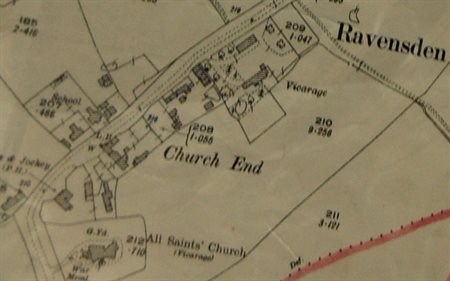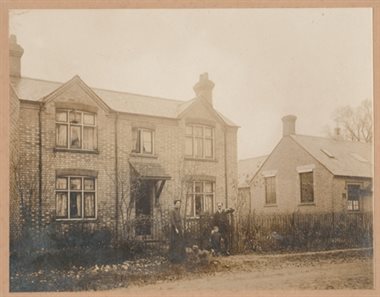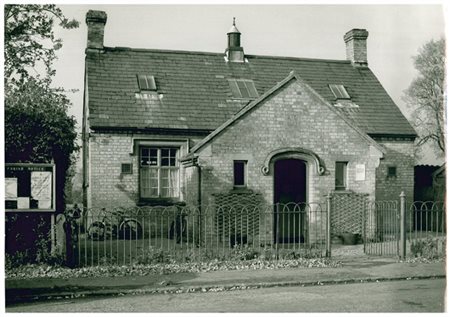Ravensden School 1904-1969
Page written by Bedfordshire Archives Staff with contributions by Trevor Stewart
In spite of the nice school master’s house built by the Ravensden Town and Poor Estate charity, and the school becoming a ‘a school maintained but not provided by the Local Education Authority’ known as a voluntary school, Mr and Mrs Benney only remained as school master and mistress at Ravensden School from 1903 to July 1905.
December 1905 saw the appointment of the long serving and greatly respected teacher, William Bishop, who came from Stafford with his wife Annie as assistant teacher. He was to remain in post for 28 years.
In 1911 the school managers acquired a piece of land (12 poles) from the Town and Poor Estate charity for the extension of the playground and so that the earth closets could be moved further away from the school building. They also asked to rent some land from the charity for use as a school garden.
In 1913 24 children achieved a perfect attendance for the year with an average of 78 children each week (school log book). However, being a rural school, attendance and the timing of the holidays had always been subject to the needs of the harvest and in time of war this became particularly important. In 1916 the managers sent a letter to the Bedfordshire County Council Education Committee ‘pointing out the difficulty of getting Harvest Work done on the farms, and strongly urging that the Children of Ravensden School be allowed two months holiday instead of the usual six weeks.’ The following year the managers proposed that the Harvest Holidays be the same as last year – seven weeks. (SDRavensden3/1).
In spite of: the need for help with the harvest, outbreaks of measles, whooping cough and scarlet fever, and several periods of heavy snow, some children did achieve excellent attendance and prizes were given out in April each year. On the 30 April 1917 the school log book records ‘Edward Carter and James Carter received silver watch chains on completing 9 and 8 yrs perfect attendance respectively, James Carter also receiving a watch from Mrs Wythes.’ Edward Levi Campbell Carter had already received a pocket watch the year before when he had reached 8 years perfect attendance. Edward (1903-1962) and James (1904-1959) were two of the children of Gertrude and James Francis Carter. At the time of the 1911 census the family lived at Church End Farm and James Francis Carter was a farm labourer.
During the First World War the school garden became very important. According to the school log book, some other lessons were put aside for gardening when it was necessary to catch up after spells of bad weather, special sessions were held after school, specialists came to teach fruit tree pruning, and one boy was allowed to join the class even though he was not yet 12. While boys concentrated on gardening the girls concentrated on knitting for the troops. On the 13th December 1915 the log book records ‘The girls have finished knitting for the troops. 16 scarves, 12 prs socks, & 22 prs mittens have been sent away, every man from the village, in the Army receiving a parcel. 9 parcels went to France, 5 to BMEF [British Expeditionary Force], one to Germany & rest to men in England.’ On the 30th April 1917 ’19 girls had silk handkerchiefs from Mrs Wythes for their work in knitting for soldiers’.

Ravensden School shown on the 3rd edition Ordnance Survey map, 1926
Mrs Bishop died in March 1925. Two years later Mr Bishop remarried but the second Mrs Bishop died in 1929. After a period of poor health William Bishop died in 1933. As well as being a Ravensden churchwarden and chairman of the Ravensden Fete committee, William had been an important member of the local National Union of Teachers, a mason and a member of the Conservative club. His funeral was attended by many people from the teaching profession and was fully reported in the local newspaper. William and Annie Bishop are buried together in Ravensden Churchyard their grave being marked by a large stone cross and kerbings. The managers record ‘the regret they feel at the loss by death of Mr Bishop. They feel that they have lost not only a good school master but a good friend to all the parish’ (SDRavensden3/1).

Mr and Mrs Bishop outside the house rented from the Ravensden Charity for use by the schoolmaster. The building to the right is the school. (Image courtesy of Mrs J Winterbottom).
Miss Annie Florence Carwood was appointed head teacher in place of Mr Bishop. Miss Carwood resigned in 1938 and Miss Evelyn Cooper was appointed headmistress. Miss Cooper was keen to have water laid on to the school and the trustees of the charity agreed to the running of a gulley to the drain serving the school house (which belonged to the charity and not the school managers) however this was delayed due to the war. It is not clear from the records when Miss Cooper may have got the tap she desired.
The war had other consequences for the school. In 1941 the managers agreed to fix the summer holiday as near as possible to harvest to enable boys that were capable to help if required. They later agreed that one-month holiday be given starting on August 15th and the remaining week be granted in October to conform with potato harvest. The same arrangements were made the following year but after that the County Council set the holidays for all schools within their LEA. In 1943 the managers agreed that ‘an application should to be made for 3 doz unbreakable mugs for the Children, for the milk used in school…attention should be drawn to the Platoon Commander of the Home Guard, for the purpose of asking the Home Guard not to interfere with the school apparatus.’ (SDRavensden3/1). In 1944 Miss Amy L Tredinnick replaced Miss Cooper.
The 1944 Education Act raised the school leaving age and brought about changes to the way schools were managed and administered. From 1948 pupils from Ravensden transferred to either a grammar school or Goldington Road school to continue their education. In 1952 the managers decided that Ravensden School should become an ‘Aided Status’ school. Ruth E Lang-Sadler was head mistress from 1954 to 1959, when she was replaced by Edith Buckley.
By 1959 it was becoming increasingly difficult to maintain the school premises, particularly the toilets. The night soil from the earth closets had been collected and used on the land by a person in the village but when this person gave up his land the managers were left with a problem. At one point there was talk of burying it in trenches in the school master’s garden but the county council proposed chemical toilets as an alternative solution.
 Ravensden School in 1962 (CA19/98/2)
Ravensden School in 1962 (CA19/98/2)
In 1961 the Archdeacon outlined the Education Authority’s plans for bringing the school up to the required standard and the following year the managers agree to leave the search for a site for a new school to the county architect. A site was identified and the purchase was said to be underway in 1965. In 1966 Messrs Chrystal and West were appointed architects for the new school, which was to have two class rooms for up to 50 children and the design should make provision for an enlargement by one classroom in 20 years given the expected expansion of the village. In 1967 there were 31 children on the role.
In January 1969 the new school in Vicarage Close was completed and was in use from February that year. On the 1st May 1969 (exactly 111 years after John Westley first signed for his school teacher’s salary) the new school was dedicated by the Bishop of Bedford the Right Rev John Hare.

Dignitaries at the opening of the school, 1 May 1969 (BTNegPostA478/3)
The old school was sold and subsequently demolished; two houses were built on the site.